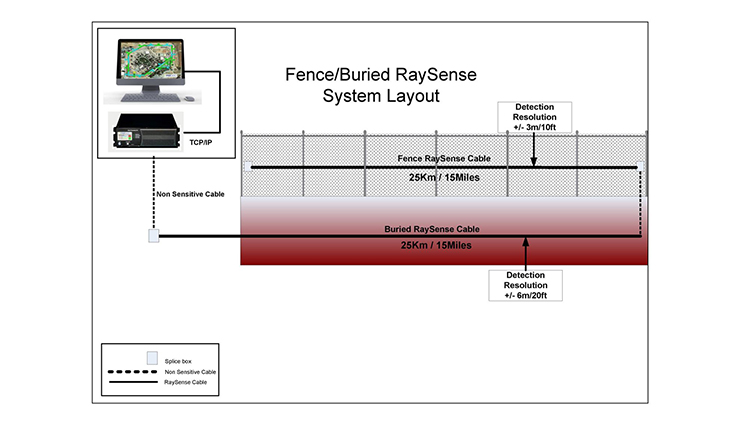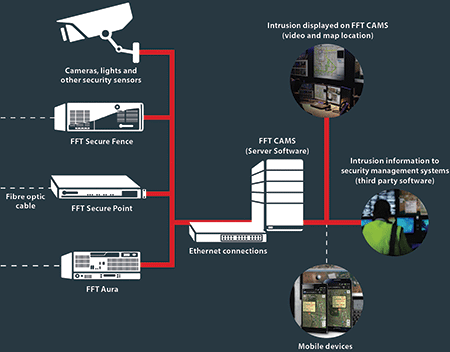Security Fibers: A Reliable Solution for Cutting-Edge Security Systems
Security Fibers: A Reliable Solution for Cutting-Edge Security Systems
Blog Article
Boost Your Security With Advanced Fiber Optic Protection Solutions
In a period where security is vital, advanced fiber optic safety and security systems offer a compelling option for boosting safety throughout numerous environments. These systems not just flaunt superior transmission capacity and speed for high-resolution monitoring but likewise supply amazing durability against outside disturbances. As organizations increasingly seek reputable ways to safeguard their assets, the integration of innovative modern technologies like AI and IoT within fiber optic frameworks elevates vital questions about their performance contrasted to traditional systems. What ramifications do these innovations hold for future safety and security measures?
Benefits of Fiber Optic Security
Harnessing the benefits of fiber optic modern technology dramatically improves safety systems across various applications. One of the key advantages is the boosted bandwidth capacity, enabling the transmission of large amounts of information at broadband. This is specifically essential for real-time video clip security, where high-resolution feeds can be sent without latency, guaranteeing immediate response capacities.
Furthermore, fiber optics exhibit superior resistance to electro-magnetic disturbance, which is important in atmospheres with possible signal interruptions. This integrity makes certain regular efficiency in crucial safety and security operations. Furthermore, fiber optic cables are less prone to tapping and unapproved access contrasted to standard copper wiring, thereby boosting information stability and confidentiality.
One more significant advantage is the longevity of fiber optic systems; they are extra resistant to environmental variables such as moisture, temperature variations, and corrosive compounds. This strength converts to reduce upkeep prices and longer lifespans for safety installments.
Lastly, the lightweight nature of fiber optic wires helps with much easier installation and routing, especially in intricate infrastructures (fiber optic security system). Eventually, the integration of fiber optic modern technology into safety systems not just strengthens protection measures but likewise enhances operational efficiency
Secret Functions to Think About
When reviewing fiber optic protection systems, numerous vital attributes must be considered to ensure optimal performance and effectiveness. First, assess the system's discovery array and level of sensitivity; an extensive range permits monitoring huge locations, while high level of sensitivity makes sure that even minor disturbances are detected promptly.
Next, consider the assimilation abilities of the system. A fiber optic safety and security system should flawlessly user interface with existing safety and security measures such as electronic cameras and alarms, creating a natural safety and security network.
Resilience and environmental resistance are additionally vital features. Make sure that the system is developed to hold up against extreme weather problems and prospective physical threats, as this will certainly prolong its functional life expectancy.

Finally, check out the scalability of the system. A durable fiber optic safety and security system should be quickly expandable to suit future needs without substantial overhauls. By thoroughly considering these attributes, you can select a fiber browse around this site optic protection service that boosts safety and protection in your environment.
Installment Process Introduction
To successfully execute a fiber optic protection system, a methodical installment procedure is vital. This procedure begins with a detailed website assessment to figure out the specific safety and security demands and to identify ideal areas for fiber optic cables and safety tools. Following this assessment, the installation group will certainly establish a detailed plan, including cord paths, necessary devices, and conformity with neighborhood regulations.
Next, the setup entails laying the fiber optic cables, ensuring they are safeguarded from ecological variables and physical damages. Correct handling techniques are vital, as fiber optic cords are delicate and can be conveniently harmed. After the cabling is mounted, connectors and terminations are carefully completed to guarantee signal stability.
The succeeding stage includes installing protection gadgets such as video cameras, motion detectors, and alarm, all integrated with the fiber optic network. Rigorous screening is carried out to verify that all parts are operating appropriately and to make certain ideal performance.

Comparing Fiber Optic to Traditional Solutions
The development of safety and security innovation has resulted in significant innovations in the contrast between fiber optic systems and conventional copper-based systems. Fiber optic systems utilize light to send data, offering superior transmission capacity and speed contrasted to their copper counterparts. This results in boosted data transmission capabilities, making optical fiber optimal for high-resolution video clip security and real-time tracking.
Furthermore, fiber optic cords are resistant to electro-magnetic interference, decreasing the likelihood of signal destruction triggered by exterior aspects. This characteristic makes certain constant efficiency, even in tough atmospheres. In comparison, conventional copper systems are more prone to disturbance, resulting in possible vulnerabilities in protection applications.
Toughness is another advantage of fiber optic systems. They are much less prone to harm from ecological elements such as dampness and temperature changes, which can endanger copper wiring. Fiber optics are lighter and thinner, permitting for easier setup and lowered physical impact.
However, standard systems often tend to have lower initial expenses, making them eye-catching for budget-conscious projects. While fiber optic systems may need a greater in advance financial investment, their long-term benefits-- such as lower maintenance expenses and higher integrity-- often outweigh the preliminary cost, placing them as a premium selection for modern security needs.
Future Trends in Safety And Security Innovation
Emerging patterns in safety innovation are positioned to change the landscape of monitoring and danger discovery - fiber optic security system. As companies progressively deal with advanced risks, advancements such as expert system (AI) and maker discovering (ML) are ending up being important to safety systems. These innovations enhance the capability additional resources of fiber optic systems by enabling real-time information evaluation, determining anomalies, and automating responses to possible violations
In addition, the assimilation of the Web of Things (IoT) is transforming security structures. IoT gadgets can offer extensive situational awareness and promote seamless communication in between different safety and security parts. This interconnectedness enables for much more efficient surveillance and faster occurrence reaction times.
Biometric authentication is additionally acquiring momentum, giving a higher degree of protection through one-of-a-kind physical features. As this innovation develops, it is most likely to be included into fiber optic systems for improved access control.
Verdict
Finally, advanced fiber optic protection systems represent a considerable innovation in security and security modern technology. Their exceptional transmission capacity, resistance to interference, and durability assist in reliable tracking and information integrity. As these systems incorporate AI and IoT capacities, they enhance the total security framework, making certain robust security for possessions. The change from conventional systems to fiber optic options reflects an expanding fad in the direction of much more effective and reliable security steps in a progressively intricate technical landscape.
Report this page